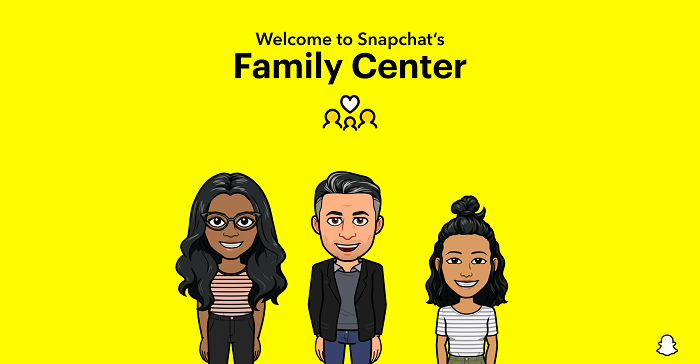SOCIAL
Snap Launches New ‘Family Center’ so Parents Can Monitor Who Their Teens are Interacting with in the App

It’s been in development for the last few months, and now, Snapchat has officially launched its new Family Center, which will enable parents to essentially monitor who their teens are engaging with in the app, while also keeping the specifics of their conversations private.
As outlined in this introductory video, the aim of the Family Center is to help parents understand how their kids are engaging in the app, without overstepping privacy grounds.
As explained by Snap:
“Family Center is designed to reflect the way that parents engage with their teens in the real world, where parents usually know who their teens are friends with and when they are hanging out – but don’t eavesdrop on their private conversations. In the coming weeks, we will add a new feature that will allow parents to easily view new friends their teens have added.”
Parents will also be able to report any accounts that may be of concern directly to Snap’s Trust and Safety teams, without alerting their child, which could help to avoid any unwanted attention that their kids might be getting in the app.
In order to access the platform, parents will need to sign up for their own Snapchat account, then access the Family Center in the app.
As outlined here, teens will need to accept an invitation from their parents to join their Family Center dashboard, so there’s full transparency in the process.
(As an aside, it could also be a way for Snapchat to boost its active user counts, as every parent who wants to utilize the Family Center will need to sign up for an account to access it.)
It’s a valuable, and important update – though it does comes with some level of risk for Snap, in respect to potentially reducing the app’s appeal.
The ephemeral nature of Snapchat has, over time, made it a key platform for more risqué, controversial sharing activity, in variance to, say, Facebook, where your whole family is watching on. But now, with parents wading into the conversation, that could make it a less appealing prospect for this type of engagement, which may water down the platform’s value for younger audiences.
Yet, at the same time, there have been various reports of how Snapchat is commonly used for sending lewd messages, and arranging hook-ups, which comes with its own level of risk, while drug dealers reportedly also now use Snap to organize meet-ups and sales.
Logically, parents will be keen to glean more insight into such – but again, I can’t imagine Snap users will be so welcoming of an intrusive tool in this respect.
Still, there’s valuable purpose here, and this seems like a compromise that Snap needs to, and should make.
But it could see at least some of this activity drifting off to other platforms instead.
In addition to this, Snap’s also planning to add additional features to its Family Center:
“… including new content controls for parents and the ability for teens to notify their parents when they report an account or a piece of content to us. While we closely moderate and curate both our content and entertainment platforms, and don’t allow unvetted content to reach a large audience on Snapchat, we know each family has different views on what content is appropriate for their teens and want to give them the option to make those personal decisions.”
Overall, it seems like a valuable addition to Snap’s protection tools, which already include measures to stop unwanted messages between adults and youngsters and limit teens from showing up in search results.
And on balance, it does seem that the potential value outweighs the potential risk in losing user engagement.
SOCIAL
Snapchat Explores New Messaging Retention Feature: A Game-Changer or Risky Move?

In a recent announcement, Snapchat revealed a groundbreaking update that challenges its traditional design ethos. The platform is experimenting with an option that allows users to defy the 24-hour auto-delete rule, a feature synonymous with Snapchat’s ephemeral messaging model.
The proposed change aims to introduce a “Never delete” option in messaging retention settings, aligning Snapchat more closely with conventional messaging apps. While this move may blur Snapchat’s distinctive selling point, Snap appears convinced of its necessity.
According to Snap, the decision stems from user feedback and a commitment to innovation based on user needs. The company aims to provide greater flexibility and control over conversations, catering to the preferences of its community.
Currently undergoing trials in select markets, the new feature empowers users to adjust retention settings on a conversation-by-conversation basis. Flexibility remains paramount, with participants able to modify settings within chats and receive in-chat notifications to ensure transparency.
Snapchat underscores that the default auto-delete feature will persist, reinforcing its design philosophy centered on ephemerality. However, with the app gaining traction as a primary messaging platform, the option offers users a means to preserve longer chat histories.
The update marks a pivotal moment for Snapchat, renowned for its disappearing message premise, especially popular among younger demographics. Retaining this focus has been pivotal to Snapchat’s identity, but the shift suggests a broader strategy aimed at diversifying its user base.
This strategy may appeal particularly to older demographics, potentially extending Snapchat’s relevance as users age. By emulating features of conventional messaging platforms, Snapchat seeks to enhance its appeal and broaden its reach.
Yet, the introduction of message retention poses questions about Snapchat’s uniqueness. While addressing user demands, the risk of diluting Snapchat’s distinctiveness looms large.
As Snapchat ventures into uncharted territory, the outcome of this experiment remains uncertain. Will message retention propel Snapchat to new heights, or will it compromise the platform’s uniqueness?
Only time will tell.
SOCIAL
Catering to specific audience boosts your business, says accountant turned coach

While it is tempting to try to appeal to a broad audience, the founder of alcohol-free coaching service Just the Tonic, Sandra Parker, believes the best thing you can do for your business is focus on your niche. Here’s how she did just that.
When running a business, reaching out to as many clients as possible can be tempting. But it also risks making your marketing “too generic,” warns Sandra Parker, the founder of Just The Tonic Coaching.
“From the very start of my business, I knew exactly who I could help and who I couldn’t,” Parker told My Biggest Lessons.
Parker struggled with alcohol dependence as a young professional. Today, her business targets high-achieving individuals who face challenges similar to those she had early in her career.
“I understand their frustrations, I understand their fears, and I understand their coping mechanisms and the stories they’re telling themselves,” Parker said. “Because of that, I’m able to market very effectively, to speak in a language that they understand, and am able to reach them.”Â
“I believe that it’s really important that you know exactly who your customer or your client is, and you target them, and you resist the temptation to make your marketing too generic to try and reach everyone,” she explained.
“If you speak specifically to your target clients, you will reach them, and I believe that’s the way that you’re going to be more successful.
Watch the video for more of Sandra Parker’s biggest lessons.
SOCIAL
Instagram Tests Live-Stream Games to Enhance Engagement

Instagram’s testing out some new options to help spice up your live-streams in the app, with some live broadcasters now able to select a game that they can play with viewers in-stream.
As you can see in these example screens, posted by Ahmed Ghanem, some creators now have the option to play either “This or That”, a question and answer prompt that you can share with your viewers, or “Trivia”, to generate more engagement within your IG live-streams.
That could be a simple way to spark more conversation and interaction, which could then lead into further engagement opportunities from your live audience.
Meta’s been exploring more ways to make live-streaming a bigger consideration for IG creators, with a view to live-streams potentially catching on with more users.
That includes the gradual expansion of its “Stars” live-stream donation program, giving more creators in more regions a means to accept donations from live-stream viewers, while back in December, Instagram also added some new options to make it easier to go live using third-party tools via desktop PCs.
Live streaming has been a major shift in China, where shopping live-streams, in particular, have led to massive opportunities for streaming platforms. They haven’t caught on in the same way in Western regions, but as TikTok and YouTube look to push live-stream adoption, there is still a chance that they will become a much bigger element in future.
Which is why IG is also trying to stay in touch, and add more ways for its creators to engage via streams. Live-stream games is another element within this, which could make this a better community-building, and potentially sales-driving option.
We’ve asked Instagram for more information on this test, and we’ll update this post if/when we hear back.
-

 PPC6 days ago
PPC6 days ago19 Best SEO Tools in 2024 (For Every Use Case)
-

 MARKETING7 days ago
MARKETING7 days agoEcommerce evolution: Blurring the lines between B2B and B2C
-
SEARCHENGINES5 days ago
Daily Search Forum Recap: April 19, 2024
-
SEARCHENGINES6 days ago
Daily Search Forum Recap: April 18, 2024
-

 WORDPRESS6 days ago
WORDPRESS6 days agoHow to Make $5000 of Passive Income Every Month in WordPress
-

 SEO7 days ago
SEO7 days ago2024 WordPress Vulnerability Report Shows Errors Sites Keep Making
-

 WORDPRESS7 days ago
WORDPRESS7 days ago10 Amazing WordPress Design Resouces – WordPress.com News
-

 SEO6 days ago
SEO6 days ago25 WordPress Alternatives Best For SEO














You must be logged in to post a comment Login